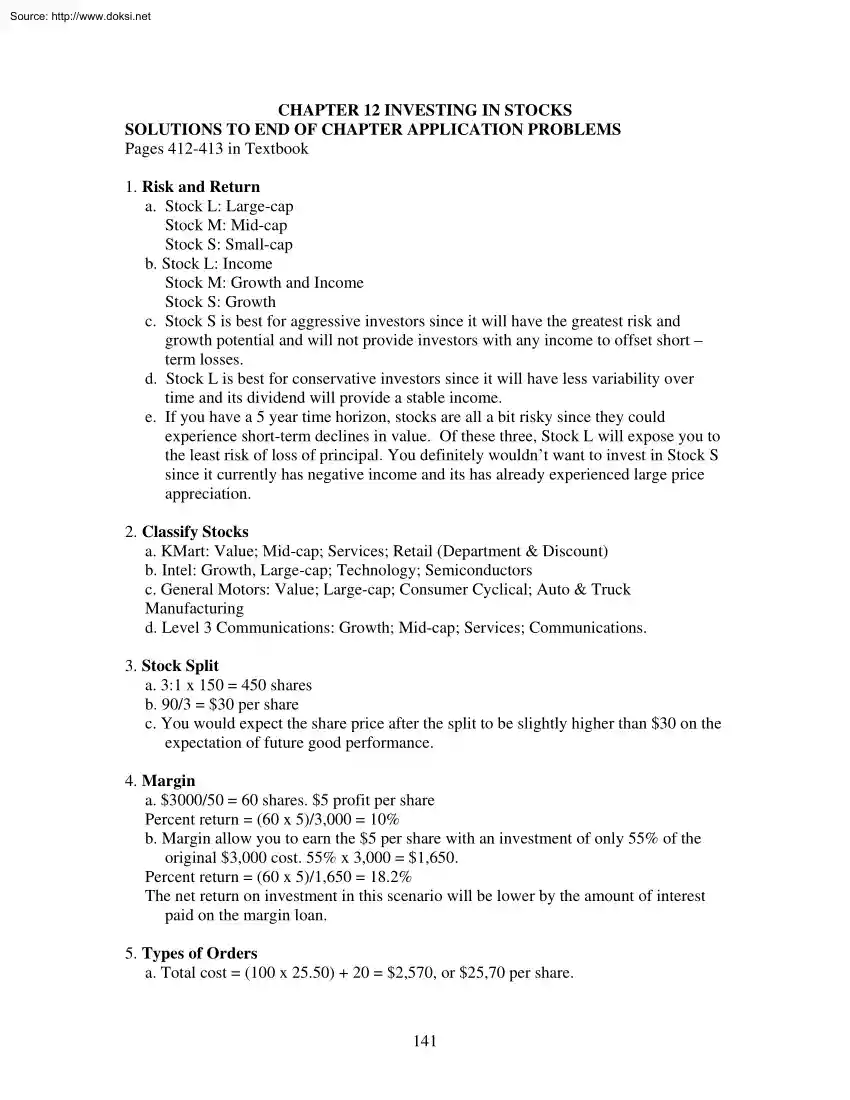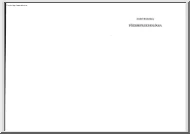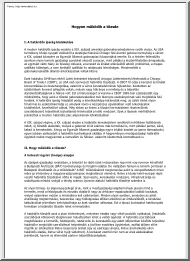Datasheet
Year, pagecount:2005, 2 page(s)
Language:English
Downloads:2
Uploaded:July 23, 2020
Size:457 KB
Institution:
-
Comments:
Attachment:-
Download in PDF:Please log in!
Comments
No comments yet. You can be the first!Most popular documents in this category
Content extract
Source: http://www.doksinet CHAPTER 12 INVESTING IN STOCKS SOLUTIONS TO END OF CHAPTER APPLICATION PROBLEMS Pages 412-413 in Textbook 1. Risk and Return a. Stock L: Large-cap Stock M: Mid-cap Stock S: Small-cap b. Stock L: Income Stock M: Growth and Income Stock S: Growth c. Stock S is best for aggressive investors since it will have the greatest risk and growth potential and will not provide investors with any income to offset short – term losses. d. Stock L is best for conservative investors since it will have less variability over time and its dividend will provide a stable income. e. If you have a 5 year time horizon, stocks are all a bit risky since they could experience short-term declines in value. Of these three, Stock L will expose you to the least risk of loss of principal. You definitely wouldn’t want to invest in Stock S since it currently has negative income and its has already experienced large price appreciation. 2. Classify Stocks a. KMart: Value; Mid-cap;
Services; Retail (Department & Discount) b. Intel: Growth, Large-cap; Technology; Semiconductors c. General Motors: Value; Large-cap; Consumer Cyclical; Auto & Truck Manufacturing d. Level 3 Communications: Growth; Mid-cap; Services; Communications 3. Stock Split a. 3:1 x 150 = 450 shares b. 90/3 = $30 per share c. You would expect the share price after the split to be slightly higher than $30 on the expectation of future good performance. 4. Margin a. $3000/50 = 60 shares $5 profit per share Percent return = (60 x 5)/3,000 = 10% b. Margin allow you to earn the $5 per share with an investment of only 55% of the original $3,000 cost. 55% x 3,000 = $1,650 Percent return = (60 x 5)/1,650 = 18.2% The net return on investment in this scenario will be lower by the amount of interest paid on the margin loan. 5. Types of Orders a. Total cost = (100 x 2550) + 20 = $2,570, or $25,70 per share 141 Source: http://www.doksinet b. Total cost = (100 x 2550) + 20 = $2,570, or $2570 per
share c. This order would not be executed since the market price has risen above your maximum. If the market price later fell to $2525 within the time period of the order, the total cost would be (100 x 25.25) + 20 = $2,545, or 2545 per share 6. Ratios a. EPS = 2,000,000/1,000,000 = $2 per share b. P/E = $3000/$200 = 15 times c. Dividend yield = $100/$2700 = 37% Note that investors who buy the stock today will expect a dividend yield of $1.00/$3000 =- 33%, if dividends don’t rise this year. d. Total return = ($1 + $30 - $27)/$27 = 148% 7. Market Risk a. Vixen Inc has the most market risk since its beta (25) is the highest The lowest beta stock (0.5) is Luke Enterprises b. Vixen Inc would be expected to experience an increase of roughly 25 x 10 = 25% c. Luke’s expected change in value would be about half of the market’s loss, or -5% d. The portfolio beta is the weighted average of the betas of the individual stocks = 1.25 8. Dividends a. 400 x 090 = $36000 this quarter b. If you
are in the 15% bracket for federal income taxes, your dividends will be taxes at the capital gains tax rate of 5%. c. $360/$6500 = 55% 9. Locking in Profits a. Her cost to buy the shares was (100 x 20) + 35 = 2,035 Because of her limit order, her stock would have been sold at $26.00, generating (100 x 26) – 35 = $2,565 to Ariel. Her return on investment was (2,565 – 2,035)/2,035 = 26% b. If she had placed a market order instead, she might have had it executed at $2550, in which case she would have gotten (100 x 25.50) – 35 = $2,515 Her return on investment would have then been (2,515 – 2,035)/2,035 = 23.6% 142
Services; Retail (Department & Discount) b. Intel: Growth, Large-cap; Technology; Semiconductors c. General Motors: Value; Large-cap; Consumer Cyclical; Auto & Truck Manufacturing d. Level 3 Communications: Growth; Mid-cap; Services; Communications 3. Stock Split a. 3:1 x 150 = 450 shares b. 90/3 = $30 per share c. You would expect the share price after the split to be slightly higher than $30 on the expectation of future good performance. 4. Margin a. $3000/50 = 60 shares $5 profit per share Percent return = (60 x 5)/3,000 = 10% b. Margin allow you to earn the $5 per share with an investment of only 55% of the original $3,000 cost. 55% x 3,000 = $1,650 Percent return = (60 x 5)/1,650 = 18.2% The net return on investment in this scenario will be lower by the amount of interest paid on the margin loan. 5. Types of Orders a. Total cost = (100 x 2550) + 20 = $2,570, or $25,70 per share 141 Source: http://www.doksinet b. Total cost = (100 x 2550) + 20 = $2,570, or $2570 per
share c. This order would not be executed since the market price has risen above your maximum. If the market price later fell to $2525 within the time period of the order, the total cost would be (100 x 25.25) + 20 = $2,545, or 2545 per share 6. Ratios a. EPS = 2,000,000/1,000,000 = $2 per share b. P/E = $3000/$200 = 15 times c. Dividend yield = $100/$2700 = 37% Note that investors who buy the stock today will expect a dividend yield of $1.00/$3000 =- 33%, if dividends don’t rise this year. d. Total return = ($1 + $30 - $27)/$27 = 148% 7. Market Risk a. Vixen Inc has the most market risk since its beta (25) is the highest The lowest beta stock (0.5) is Luke Enterprises b. Vixen Inc would be expected to experience an increase of roughly 25 x 10 = 25% c. Luke’s expected change in value would be about half of the market’s loss, or -5% d. The portfolio beta is the weighted average of the betas of the individual stocks = 1.25 8. Dividends a. 400 x 090 = $36000 this quarter b. If you
are in the 15% bracket for federal income taxes, your dividends will be taxes at the capital gains tax rate of 5%. c. $360/$6500 = 55% 9. Locking in Profits a. Her cost to buy the shares was (100 x 20) + 35 = 2,035 Because of her limit order, her stock would have been sold at $26.00, generating (100 x 26) – 35 = $2,565 to Ariel. Her return on investment was (2,565 – 2,035)/2,035 = 26% b. If she had placed a market order instead, she might have had it executed at $2550, in which case she would have gotten (100 x 25.50) – 35 = $2,515 Her return on investment would have then been (2,515 – 2,035)/2,035 = 23.6% 142





 Just like you draw up a plan when you’re going to war, building a house, or even going on vacation, you need to draw up a plan for your business. This tutorial will help you to clearly see where you are and make it possible to understand where you’re going.
Just like you draw up a plan when you’re going to war, building a house, or even going on vacation, you need to draw up a plan for your business. This tutorial will help you to clearly see where you are and make it possible to understand where you’re going.